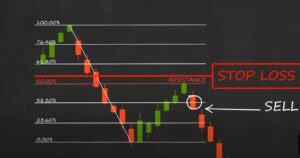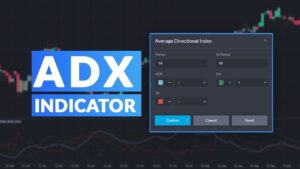The world of financial markets thrives on information and the ability to interpret it effectively. Technical analysis plays a crucial role in this process, offering a toolbox of indicators to gauge trends, predict future movements, and identify potential entry and exit points for trades. Among these indicators, the Displaced Moving Average (DMA) stands out as a versatile tool that can be customized to enhance a trader’s strategic decision-making.
Understanding the Displaced Moving Average (DMA)
At its core, a DMA is a modified version of a traditional moving average (MA). A standard MA calculates the average price of an asset over a specific period, smoothing out price fluctuations and revealing the underlying trend. The DMA takes this concept a step further by introducing a displacement, essentially shifting the entire MA calculation forward or backward in time.
There are two ways to interpret this displacement:
- Positive Displacement: When a positive value is applied, the DMA is shifted forward in time. This implies the MA is calculated based on prices expected in the future, attempting to be a leading indicator of price movements.
- Negative Displacement: Conversely, a negative displacement shifts the DMA backward in time. This results in a lagging indicator that can provide a more centered view of the historical price movement relative to the current price.
The choice of displacement value depends on the trader’s goals. A small positive displacement might help identify potential trend reversals earlier, while a larger negative displacement can offer a clearer picture of the historical support and resistance levels.
Benefits of Using a Displaced Moving Average
There are several advantages to incorporating DMAs into your technical analysis strategy:
- Reduced Whipsaws: Traditional MAs can generate false signals due to their inherent lagging nature. DMAs, particularly those with a small positive displacement, can help reduce these “whipsaws” by potentially anticipating future price movements.
- Improved Trend Following: DMAs can enhance trend identification by filtering out noise and highlighting the underlying price direction. This allows traders to capitalize on strong trends with more confidence.
- Dynamic Support and Resistance: By adjusting the displacement value, traders can create dynamic support and resistance zones that adapt to changing market conditions. This can be helpful in setting entry and exit points for trades.
- Customization: Unlike traditional MAs, DMAs offer the flexibility to experiment with different displacement values and moving average types (simple, exponential, etc.) to find the configuration that best suits the asset and trading timeframe.
Utilizing DMAs in Trading Strategies
Once you understand the concept of DMAs, you can integrate them into your trading strategies in several ways:
- Crossover Signals: Similar to traditional MAs, DMAs can be used to generate buy and sell signals based on crossovers. When a price line crosses above a positively displaced MA, it might indicate a potential buying opportunity. Conversely, a price crossing below a negatively displaced MA could suggest a selling signal.
- Divergence: Divergence between price movements and the DMA can be a valuable tool. If the price continues to rise while the DMA stagnates or declines, it could signal a potential trend reversal. Conversely, a price decline with a rising DMA might indicate a weakening downtrend.
- Confirmation: DMAs can be used alongside other technical indicators to confirm trading signals. For example, a bullish crossover signal on the DMA might be validated by a supportive Relative Strength Index (RSI) reading.
Here’s an example: Imagine you’re analyzing a stock chart with a 50-period simple moving average (SMA). You suspect the uptrend might be nearing a reversal. By introducing a positive displacement of 5 periods to the SMA, you create a 50-period displaced moving average (DMA). If the price action starts to deviate from the DMA, potentially falling below it, you might interpret this as a confirmation of a potential trend reversal and consider exiting your long position.
Important Considerations for Using DMAs
While DMAs offer several benefits, it’s crucial to be aware of their limitations:
- False Signals: Even with displacement, DMAs are not foolproof indicators and can generate false signals, especially in volatile markets. Combining DMAs with other technical indicators can help mitigate this risk.
- Optimization: Finding the optimal displacement value requires experimentation with different periods and backtesting on historical data. What works for one asset or timeframe might not be effective for another.
- Market Context: DMAs should be used in conjunction with a broader understanding of market conditions, fundamental analysis, and risk management strategies.
The Displaced Moving Average adds another dimension to the technical analysis toolbox. By understanding its functionality and limitations, traders can leverage DMAs to gain a more nuanced perspective on price movements, potentially improve their trading strategies, and make informed decisions in the often-uncertain world of financial markets. Remember, successful trading involves a combination of technical analysis, fundamental analysis, risk management practices, and a healthy dose of discipline.
Here are some additional tips for using DMAs effectively:
- Start Simple: Begin with a basic understanding of DMAs and experiment with small displacement values. Gradually increase the complexity as you gain experience.
- Focus on Confirmation: Don’t rely solely on DMAs for trading signals. Use them to confirm signals generated by other indicators or identify potential entry and exit points within your existing trading strategy.
- Backtest Extensively: Before deploying DMAs with real capital, backtest them on historical data to assess their effectiveness under various market conditions. This helps you identify ideal displacement values and understand how the indicator performs in different scenarios.
- Stay Updated: The financial markets are constantly evolving. Keep yourself informed about new developments and adapt your trading strategies accordingly, including how you utilize DMAs.
By following these guidelines and continuously refining your approach, you can unlock the potential of Displaced Moving Averages and enhance your technical analysis capabilities. Remember, there’s no single “magic formula” for success in trading. However, by incorporating DMAs thoughtfully and strategically, you can equip yourself with a valuable tool to navigate the ever-changing dynamics of the financial world.
Let’s Have Forex Trade Copying Service From Expert Traders!
Fx Pips Guru is a forex trade copying service provider company from expert forex traders. Let’s do Live Chat with our experts.




